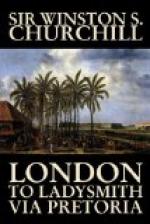I draw a rough diagram to assist the reader who will take the trouble to study the map. It is only drawn from memory, and its object is to show how completely the Monte Cristo ridge turned both the line of entrenchments through Colenso and that before Pieters. But no diagrams, however exaggerated, would convince so well as would the actual ground.
[Illustration: Plan of the Colenso Position.]
In the belief, however, that the enemy were in retreat the General resolved to cross the river at A by a pontoon bridge and follow the railway line. On the 21st, therefore, he moved his army westward across the Hlangwani plateau, threw his bridge, and during the afternoon passed his two leading infantry brigades over it. As soon as the Boers perceived that he had chosen this line of advance their hopes revived. ‘Oh,’ we may imagine them saying, ’if you propose to go that way, things are not so bad after all.’ So they returned to the number of about nine thousand burghers, and manned the trenches of the Pieters position, with the result that Wynne’s Lancashire Brigade, which was the first to cross, soon found itself engaged in a sharp action among the low-kopjes, and suffered a hundred and fifty casualties, including its General, before dark. Musketry fire was continuous throughout the night. The 1st Cavalry Brigade had been brought in from Springfield on the 20th, and on the morning of the 22nd both the Regular and Irregular Cavalry were to have crossed the river. We accordingly marched from our camp at the neck between Cingolo and Monte Cristo and met the 1st Cavalry Brigade, which had come from Chievejey, at the pontoon bridge. A brisk action was crackling away beyond the river, and it looked as if the ground scarcely admitted of our intervention. Indeed, we had hardly arrived when a Staff Officer came up, and brought us orders to camp near Hlangwani Hill, as we should not cross that day.
Presently I talked to the Staff Officer, who chanced to be a friend of mine, and chanced, besides, to be a man with a capacity for sustained thought, an eye for country, and some imagination. He said: ’I don’t like the situation; there are more of them than we expected. We have come down off our high ground. We have taken all the big guns off the big hills. We are getting ourselves cramped up among these kopjes in the valley of the Tugela. It will be like being in the Coliseum and shot at by every row of seats.’
Sir Redvers Buller, however, still believing he had only a rearguard in front of him, was determined to persevere. It is, perhaps, his strongest characteristic obstinately to pursue his plan in spite of all advice, in spite, too, of his horror of bloodshed, until himself convinced that it is impracticable. The moment he is satisfied that this is the case no considerations of sentiment or effect prevent him from coming back and starting afresh. No modern General ever cared less for what the world might say. However unpalatable




